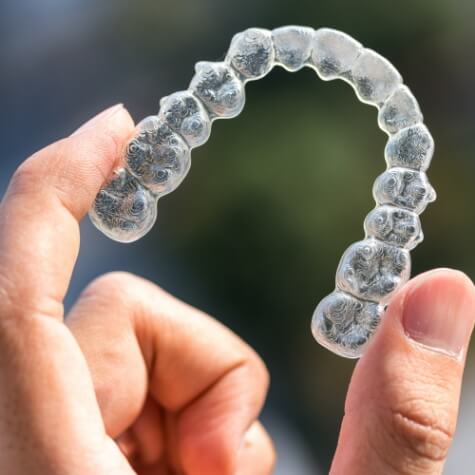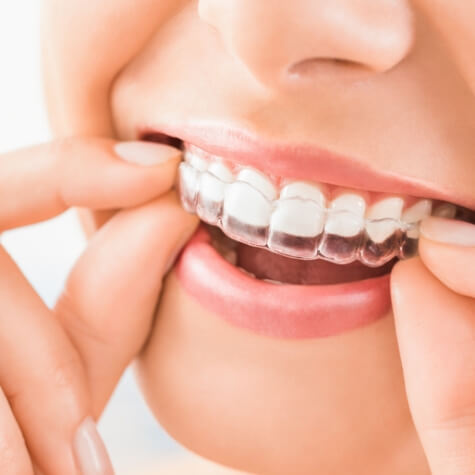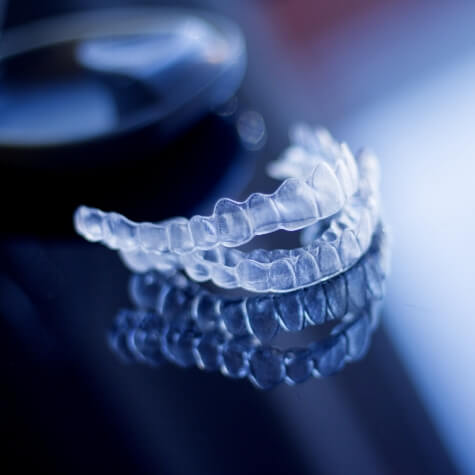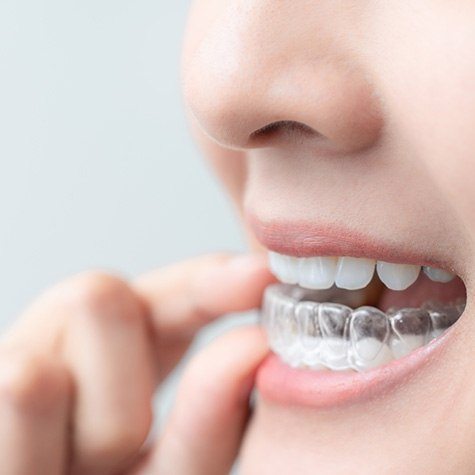Advancements in dentistry now make it possible for teens and adults to enjoy a more discreet way to straighten teeth. With Invisalign, smiles can move into proper alignment in a more flexible, subtle, and comfortable way. Our team at Villagio Family & Cosmetic Dental can develop a plan that addresses overcrowding, gaps, and even bite misalignment so that patients can see a drastic improvement that leads to better oral and overall health. Call us to schedule an appointment today if you or your teen is interested in learning more about Invisalign clear aligners in Fulshear.
Why Choose Villagio Family & Cosmetic Dental for Invisalign Clear Aligners?
- Your Dental Insurance PPO Plan is Welcome
- We Offer Convenient Appointment Times (Weekends & Evenings)
- Dental Experts with Decades of Experience & Training
How Invisalign Works
Invisalign consists of clear plastic aligners that are made to correspond with a patient’s teeth as they move through treatment. When worn 20-22 hours a day, gentle, continuous pressure is applied to keep teeth moving in the right direction. After 1-2 weeks, the current set is swapped out for the next one in the series, as this ensures that teeth continue to shift toward proper alignment.
The Benefits of Invisalign
If you want to straighten your teeth, Invisalign isn’t your only option. It is, however, one of the most popular. In fact, more than 17 million patients have used clear aligners to address overcrowded, spaced-out, and otherwise misaligned teeth. If you’re considering doing the same, then read on to learn a few of the many benefits you can expect!
Greater Comfort

Although they are effective, traditional braces aren’t the most comfortable. Fortunately, Invisalign uses clear, custom-made aligners instead of metal brackets and wires. So, you don’t have to worry about soft tissue irritation. Plus, if you do feel any soreness or pressure from the movement of your teeth, you can always take OTC pain medication to help keep you comfortable!
No Dietary Restrictions

With traditional braces, whole apples, popcorn, almonds, and other crunchy foods need to be avoided. Although this guideline is in place for good reason (it helps prevent orthodontic emergencies), it isn’t the most convenient. Fortunately, Invisalign offers greater flexibility by eliminating the possibility of food getting stuck between brackets and wires. Just remove your trays to eat or drink anything but water!
Easy Maintenance
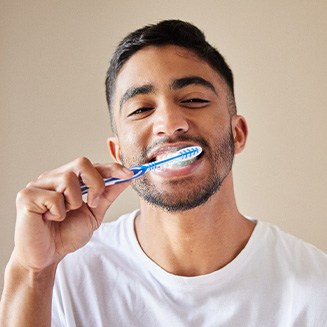
Patients with traditional braces often have a bit of difficulty cleaning around the metal brackets and wires, resulting in more cumbersome and time-consuming oral hygiene regimens. Don’t worry – that’s not the case with Invisalign. In fact, it’s simple and easy; use a soft-bristled toothbrush, clear soap, and lukewarm water to clean them twice a day. If you want, you can use a clear aligner cleaner too!
Faster Results

Before creating your treatment plan, we need to determine a few factors unique to your case, including how complex it is. That said, the average timeframe for Invisalign is 12-18 months, which is vastly different than traditional braces, which can take 2-3 years. So, there’s a good chance you’ll get the results you want faster with clear aligners!
Quick Follow-Up Visits
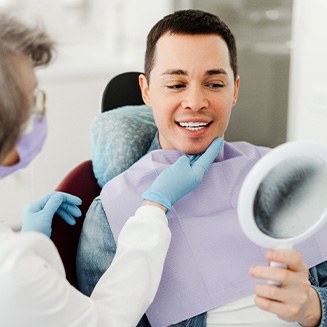
Another considerable perk: there aren’t hour-long, monthly adjustment appointments with Invisalign. Instead, the progress visits are every 6-8 weeks. We’ll take new scans, monitor the movement of your teeth, and answer any questions you have about the teeth-straightening process. If everything looks good, you’ll be in and out of our office in 20 minutes or less!
See-Through Aligners

Naturally, this list wouldn’t be complete without touching on the fact that the aligners are basically invisible. This ensures that no unwanted attention is drawn to your smile during the teeth-straightening process. Plus, it allows you to see all of the improvement along the way! Just make sure to take good care of your aligners so they stay stain and odor-free.
We Offer Multiple Types of Clear Braces
Apart from Invisalign, our team is pleased to offer other types of clear braces in Fulshear. We can sit down and discuss each option with you so that you have a better understanding of which one might be right for your unique needs. Once we go over the pros and cons of each as well as answer any of your questions, we can formulate a plan that helps you move one step closer to a more perfectly aligned smile.
Who Can Invisalign Help?
If you are interested in Invisalign – whether it’s to correct a small gap between your two front teeth or more considerable overcrowding – you shouldn’t hesitate to schedule a consultation with Dr. Z. At your appointment, she will conduct a comprehensive oral exam in order to determine the complexity of your case and, in turn, if you’re a candidate for clear aligners. Until then, you can read on to learn more about the common orthodontic problems Invisalign can correct.
Crowded Teeth
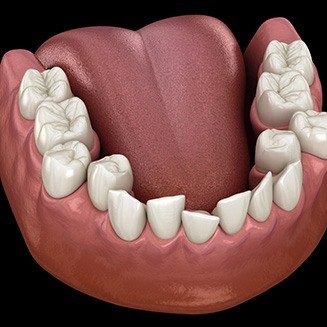
If there isn’t enough room in your mouth, your teeth will crowd together, overlapping in the process. Some patients with this orthodontic problem schedule an appointment with us because they aren’t happy with the aesthetic drawbacks. However, even if you are happy with how your smile looks, you should explore your treatment options. After all, crowded teeth can lead to several oral health problems, including tooth decay and periodontal disease.
Gaps Between Teeth
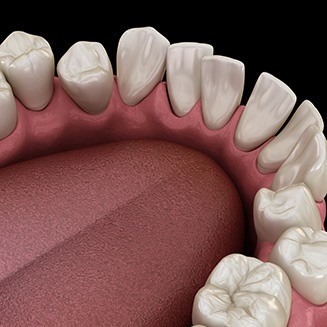
Unfortunately, gaps between your teeth can harbor plaque, food particles, and other debris, just like crowded teeth. That’s why the risk of oral health issues is higher among patients with this orthodontic problem. The good news is that Invisalign is often a solution. If that’s the case for you, then we can close the gaps, improve the alignment of your bite, and give you the gorgeous smile you’ve always wanted – without any metal.
Overbite
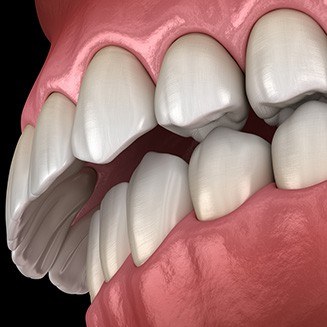
If you have a healthy bite, your upper teeth sit in front of your bottom ones. If there is a considerable gap between the two, however, then problems like chronic jaw pain and trouble enunciating clearly can occur. The good news is that moving your bite into proper alignment doesn’t always mean metal braces. Invisalign has helped countless patients with this bite problem over the years with the help of orthodontic accessories, like rubber bands.
Underbite
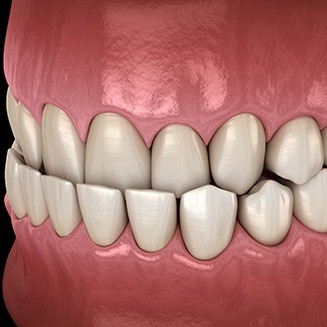
As we mentioned above, your upper teeth sit in front of your bottom ones. If the opposite is true for you, then you likely have an underbite. Unfortunately, this bite problem can lead to everything from TMJ dysfunction and chronic jaw pain to trouble enunciating clearly and smiling confidently. For all of those reasons, we recommend scheduling a consultation with us to find out if you’re a candidate for Invisalign. We may be able to give you a healthy bite without any metal!
Crossbite
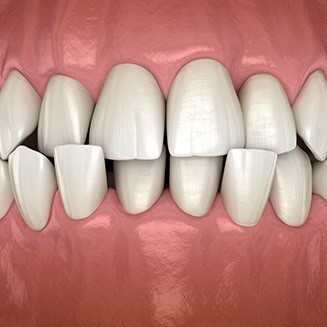
Crossbites are also quite common and, as you may have guessed, can take a serious toll on the look, health, and function of your smile. So, don’t wait until your teeth are chipped or your jaw is hurting to schedule a consultation with us! If you’re a candidate for Invisalign, we can move your teeth and bite into proper alignment, preventing chronic jaw pain, TMJ dysfunction, and other common problems in the process.
Open Bite
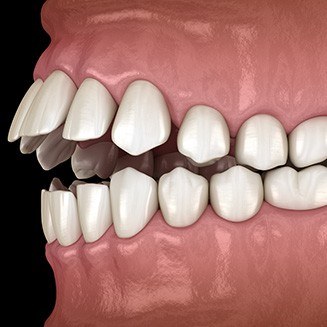
When you bite down, is there space toward the front or back of your mouth? If you answered “yes,” then you may have an open bite. Don’t worry – that doesn’t necessarily mean you need metal braces. In mild and moderate cases, Invisalign is often an option!
Invisalign FAQs
When you first get your aligners (and when you transition to each new set in the series), you can expect to feel some pressure. This is actually good news: it means your trays are working to guide your teeth into their properly aligned positions! You can always take OTC pain medication as directed to alleviate the soreness you feel. Sipping on cool water and eating soft foods will help too.
Simply put, if you don’t wear your aligners for the recommended amount of time, your teeth won’t move as anticipated. Not only will this lead to considerable treatment plan delays, but it may incur additional costs. That’s why patients across the board are asked to wear their trays for 20+ hours a day, every day.
Tip: If you are having trouble meeting the wear time, try designating a certain amount of time for each aligner-free task. For example, 30 minutes for breakfast, 40 minutes for lunch, and 50 minutes for dinner. You can use the timer on your phone as a guide too; many patients find that incredibly helpful!
While there technically aren’t any dietary restrictions with Invisalign, there are some foods we recommend avoiding simply because they increase your chances of developing tooth decay. For example, ice cream, potato chips, and other sugary and starchy snacks should be kept to a minimum. Others, like taffy, sour gummies, and peanut brittle, should pretty much be avoided entirely since they can damage both your teeth and your attachments.
On average, Invisalign takes between 12 and 18 months to deliver results. That said, it’s possible for your teeth-straightening journey to be shorter or longer than that – it depends largely on the complexity of your case! How well you follow the guidelines provided, like wearing your aligners for 20+ hours a day, will also play a role. So, make them a priority throughout your orthodontic treatment.
Once your teeth are in their perfectly aligned positions, we have another important job: keeping them there! To accomplish this, we will take impressions of your teeth and have a custom retainer made. Wearing it each night will dramatically reduce your risk of orthodontic relapse, which is a phenomenon when teeth begin to shift back into their previously misaligned positions.
You cannot drink coffee (even iced coffee) while you’re wearing your aligners. There are a few reasons for this, starting with the fact that dark-colored beverages will quickly stain them. So, make sure to take them off first. In fact, it’s a good idea to enjoy your morning cup alongside your breakfast since they will already be off, reducing your aligner-free time in the process.

